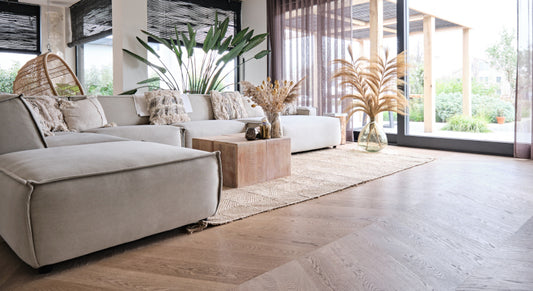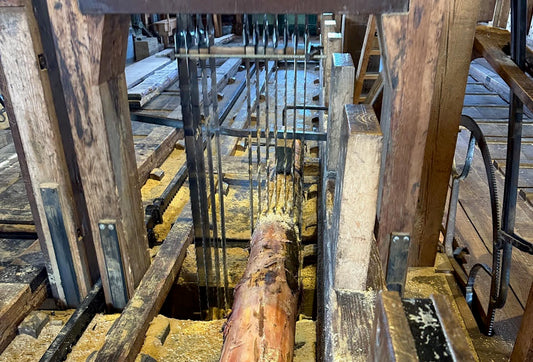Het Elleboog Patroon: Een Tijdloze Vloer Met Een Historisch Accent

Datum: 5 augustus 2023
Leestijd: 5 minuten
Auteur: Uipkes Houten Vloeren
The elbow pattern is a classic and versatile floor design that has stood the test of time. This floor style, also known as the variation on the herringbone floor, is a popular choice for both traditional and modern interiors. In this article we will take a closer look at the elbow pattern, explore its history and explore the reasons behind its enduring popularity.
Bezoek de showroom
The Elbow Pattern: A Historical Background
The origins of the elbow pattern date back to the time of the ancient Romans. Archaeological excavations show that the Romans already used this pattern in the construction of roads and floors. They called it "Opus spicatum," which refers to the plant's 'spike pattern'.
In the Middle Ages, the elbow pattern became popular as a bold and elegant choice for castle floors and other high-end construction projects. The pattern became associated with wealth and refinement, making it a symbol of prestige and style.
The Use Of The Elbow Pattern In Various Cultures
The elbow pattern found its way into different cultures around the world and was adapted to regional aesthetics and traditions. In Europe, the pattern was often used in luxurious mansions and palaces, while in American architecture it was common in historic buildings, such as old libraries, courthouses, and government buildings. In Asian cultures, the elbow pattern was reinterpreted in carvings and tilework, and it was also applied in the construction of traditional temples and pavilions. "As an age-old symbol of refinement, the elbow pattern embraces us with its intriguing zigzag movement, as an ode to the art of timeless design."
Magazine Vol inspiratie
A Timeless Aesthetic
What makes the elbow pattern so attractive is its timeless aesthetic and versatility. The pattern adds a sense of movement and depth to the floor, making it a visually intriguing element. Moreover, it can be made in different materials, such as wood, tiles or brick, making it suitable for both classic and modern interiors.
The Elbow Pattern In Modern Design
Despite its historical roots, the elbow pattern has made a remarkable comeback in contemporary architecture and interior design. Designers and architects have reinterpreted it and combined it with contemporary elements, giving it a fresh and modern look. It is now often used in combination with minimalist interiors, where it forms a striking visual accent.
Thuis advies op maat?
In modern times, the elbow pattern has proven itself as a sustainable choice in interior design, thanks to the use of biobased products such as wood. Below we look at some aspects that make the elbow pattern sustainable:
1. Biobased wood: An environmentally friendly choice
Using wood as the basis for the elbow pattern is an environmentally friendly choice, because wood is a renewable resource. Wood comes from trees that absorb CO2 as they grow, making it one of the most sustainable building materials. Choosing biobased wood contributes to reducing the ecological footprint and promotes a circular economy.
2. Sustainable forest management and certification
To ensure that the wood for the elbow pattern comes from sustainable sources, manufacturers can choose wood that is certified by organizations such as FSC (Forest Stewardship Council) or PEFC (Programme for the Endorsement of Forest Certification). These certifications guarantee that the wood comes from responsibly managed forests, taking social, ecological and economic aspects into account.
3. Energy efficiency with underfloor heating and cooling
The elbow pattern is suitable for underfloor heating and cooling systems. These systems provide an energy-efficient way to heat a space in the winter and keep it cool in the summer. Underfloor heating uses low-temperature heating, resulting in lower energy costs and reduced energy consumption compared to traditional heating systems.
Inspiratie & Informatie
4. Longer service life
The elbow pattern, especially if it is made of high-quality wood and professionally installed, can last for decades. By investing in a sustainable floor with a long lifespan, consumers can reduce their ecological footprint by having to carry out floor renovations less often.
5. Timeless aesthetics and fewer trends
Sustainability in interior design also includes avoiding short-lived trends that lead to frequent changes in decoration. The elbow pattern has a timeless aesthetic that won't go out of style anytime soon, making it less likely that people will replace the flooring due to changing trends.
In short, the elbow pattern as a floor design offers sustainability in the broadest sense of the word. The use of biobased wood, its compatibility with energy-efficient underfloor heating and cooling systems, and its long lifespan make it an environmentally friendly and economically responsible choice for contemporary interiors.
"The elbow pattern, like a dance of shapes, adds a timeless elegance to any space, where past and present come together harmoniously."
Conclusion
The elbow pattern is an intriguing floor style with a rich history. From the ancient Romans to modern architects, the pattern has stood the test of time and remains a beloved choice for many. Its timeless aesthetic and versatility have ensured that it has had a lasting impact on interior design around the world. Whether used in classic or contemporary environments, the elbow pattern is expected to continue to have a place in the world of architecture and design.
Vragen? Kom langs voor advies!
Frequently Asked Questions
What is an elbow pattern in floor design?
The elbow pattern, also known as the Herringbone pattern, is a floor design in which rectangular tiles, planks or stones are placed in a herringbone pattern. The elements are arranged at a 90 degree angle to each other, creating a zigzag or elbow-like appearance.
What is the history behind the elbow pattern?
The history of the elbow pattern dates back to the ancient Romans, who used this pattern to build roads and floors. In the Middle Ages it became popular in castles and palaces as a sign of wealth and refinement. Since then, the pattern has spread across cultures and evolved into different materials and styles.
Why is the elbow pattern so popular in interior design?
The elbow pattern is popular for its timeless aesthetic and versatility. It adds a sense of movement and depth to the floor, making it a visually appealing element. Furthermore, it fits well in both traditional and modern interiors, making it a popular choice for designers.
What materials are often used for the elbow pattern?
The elbow pattern can be made from different materials, such as wood, tile, brick, and even natural stone. Wooden elbow floors radiate a warm and classic look, while tiles and bricks are more suitable for modern or industrial interiors.
Is the elbow pattern difficult to install?
Installing an elbow pattern can be a little more challenging than a standard straight floor, especially when working with precise angles. However, a professional installer can place the pattern with precision, ensuring a perfect finish.
How can I integrate the elbow pattern into my interior?
The elbow pattern can be integrated into your interior in various ways. You can choose to use it as a floor in rooms such as the living room, dining room or hallway, or use it as an accent wall. Moreover, it can also be used in smaller elements such as furniture, decorative accessories or even in wallpaper patterns. The most important thing is to unleash your creativity and enjoy the elegant look that the elbow pattern can give to your space.
Stay up to date with news about floors and interior




